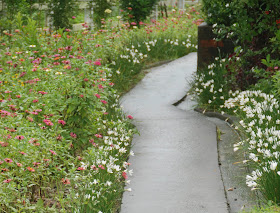
The time when storms are predicted to hit the southern Tagalog region, is an interesting time to take photos. Even if everything becomes wet and muggy, it is also a time of quiet meditation with nature. There are fewer vistors coming to the upland areas of Cavite. Neighboring organic farms will plant inside their greenhouses, lettuce, cherry tomatoes and a variety of culinary herbs.
My farm is located in the watershed area, and everything will slowly return to an exotic rainforest. Jungle vines will wrap around even the tallest trees, and elephant grass, and wild weeds will take over quickly if these are not pulled out in its early stages.
There are plants that sprout only during the rainy season. The few hardwood trees will drink up the volume of water pouring from the clouds and dig deeper into the ground to anchor their roots into the many subterranean wells that feed them all year round. To be able to boost enough energy to reach their mature growth, certain plants will not bloom until the summer heat comes back. A few varieties of tropical trees bear fruits with khaki colored skins, and the flesh and pulp of the fruits like santol, and lanzones, longan are white and very sweet.
The transformation of my farm into a rainforest was occuring before my eyes on the afternoon of 27 June, 2009. I looked up, and saw the clouds darkening from powdery white to gray. My farm took on an overcast atmosphere, and as the sunlight began to fade, the male geckos began to chant for a willing female to meet them in a puddle somehwere. Crickets joined in, and it was just an hour or two before large drops fell from the sky.
June is a month that sits on the shoulder of the hurricane season in the Philippines. I can feel the temperatures going abruptly from a cool 26 C when its raining to a steamy 32C in a few hours after a downpour. A few bad storms are predicted this year, but unless a typhoon makes a direct hit, my farm can withstand the hurricane season, for we are on high ground.

Texture and the different shapes of leaves break the monotony of green in the garden. Xanadu plant in a clay urn is located near my greenhouse.

The rainforest plants must compete for the attention of few pollinators hunting for sources of nectar. These exotic plants are only seen in botanical displays in temperate countries but only in tropical environments can one experience their natural beauty with the steamy humidity that brings out some of the more intense aromas of their blooms.

This is a variety of jasmine has a peculiar name.
The local name
of this plant is:
"Yesterday,
Today &
Tomorrow"
and the name implies the fickle attitude of youthful romance!
The flowers are white the first day, then turn purple the next and after a day begin to fade to a lemon yellow before dropping off. The aroma of the flowers is very intense and is used to create a base for only the most expensive perfumes.
This curcuma flower is used for floral arrangements, but it is actually an herbal plant. Tumeric powder is made from drying and grinding its root. This is a well known culinary ingredient for Asian cooking.

This herbal plant, and its roots are used to make dishes such as curry and laska in Southeast Asia.

Wind Chimes hung on my santol tree.

Bromeliads continue to provide color variations during the typhoon season.

This bromeliad looks like someone gave it a "french manicure" and painted the end of the leaves with a little dab of pink polish!

The fuschia colors of the Adenium Obesum or Bangkok Kalatuchi liven up the garden.

The "Falling Bird" Heliconia plant attracts birds and the hummingbird moth that I hope to catch feeding on these exotic blooms.
I am happy that there has been a brief respite from the rains to allow me to harvest my "baby sweet corn" variety. The kernels are small and ideal to be grounded up for "cream of corn" baby food. Older people prefer this type of corn because it is easy to digest.

Dainty lavander asters greet me from my kitchen window.

Thank you for stopping by, and I offer up prayers for everyone who visits my garden blog! See you all again next week.





































